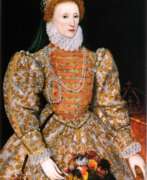Monarchs 16th century


Elizabeth I was Queen of England and Ireland from 1558 to 1603 and was the last monarch of the Tudor dynasty.
Elizabeth was the daughter of Henry VIII and Anne Boleyn, his second wife, who was executed when Elizabeth was two years old. Her youth was full of uncertainties, and her chances for the throne seemed very slim. Against all odds, however, Elizabeth inherited the throne after the death of her half-sister in November 1558. She was very well educated, fluent in five languages, intelligent, determined, and shrewd.
Above all, Elizabeth was committed to maintaining peace and stability in England. Her 45-year reign is considered one of the most glorious in English history, a path of triumph and success. Under her rule a secure Anglican church was established. Elizabeth's reign was marked by many bold discoveries, and the arts flourished as well.
Elizabeth chose never to marry. She used her prospects of marriage as a political tool in foreign and domestic politics. However, the "virgin queen" was presented as a selfless woman who sacrificed personal happiness for the good of the nation.


Henry VIII was King of England and Ireland, who ruled from 1509 to 1547.
Henry VIII was one of England's most famous monarchs, he launched the English Reformation and broke with the Roman Church to form the Church of England. He had six wives, including Anne Boleyn.


Mary, Queen of Scots, also known as Mary Stuart, was Queen of Scots from the 6th day of her life, actually ruling from 1561 until her deposition in 1567, and Queen of France from 1559-1560.
Mary was the only child of King James V of Scotland and his French-born wife, Marie de Guise. Six days after her birth, her father died and Mary became queen of Scotland, although the country was ruled by regents until her adulthood. From the age of five she was brought up at the court of King Henry II of France and Catherine de Medici. In 1558 Mary married the future King Francis of France, becoming queen consort of France from his accession to the throne in 1559 until his death in December 1560. Widowed at the age of 18, she returned to Scotland in August 1561 and, unable to run the state herself, without wise advisors, began her path to disaster.
In 1565 Mary married for love her half-cousin Henry Stuart, Lord Darnley, who under still mysterious circumstances was murdered two years later, and Mary immediately married James Hepburn, 1st Duke of the Orkney Islands, who was suspected of the Stuart murder. These unwise marital and political actions of hers provoked a revolt among the Scottish nobility.
On July 24, 1567, she was forced to abdicate in favor of her year-old son James VI and recklessly fled to England. In England, however, Mary Stuart was perceived as a threat to the throne, and Queen Elizabeth I kept her locked up in various castles around the country for 18 years. Eventually in 1586 Mary was found guilty of conspiring to murder Elizabeth and was beheaded at Fotheringhay Castle the following year. She was only 44 years old.